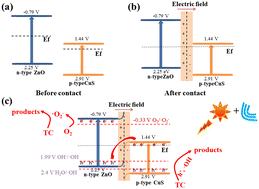Significant improvement and mechanism of tetracycline degradation with the synergistic piezoelectric effect of ZnO/CuS Z-scheme heterojunction photocatalysts†
Abstract
In the current work, a CuS nanoflower-modified ZnO nanorod heterojunction was synthesized by a two-step hydrothermal method. A synergetic piezo-photocatalytic system was constructed successfully based on the piezoelectric effect of ZnO nanomaterials and the narrow bandgap of CuS, which has the advantages of both photocatalytic heterojunction and piezocatalysis. It was demonstrated that after the introduction of a polarization electric field by ultrasonication, the degradation efficiency of ZnO/CuS composites on tetracycline hydrochloride (TC) via piezo-photocatalysis reached 85.28%, which was much higher than that of a single photocatalysis (73.89%) or piezocatalysis (40.51%) system. The significant enhancement of piezo-photocatalytic activity was attributed to the generation of a polarization electric field, which provided the driving force for the electrons and holes to migrate in opposite directions at the interface of the ZnO/CuS heterostructure, enabling ordered migration and further efficient separation of charges. This work realized the synergistic coupling of piezocatalysis and photocatalysis, providing a reference for the design and development of highly efficient piezo-photocatalysts.

- This article is part of the themed collection: Nanomaterial applications in water


 Please wait while we load your content...
Please wait while we load your content...